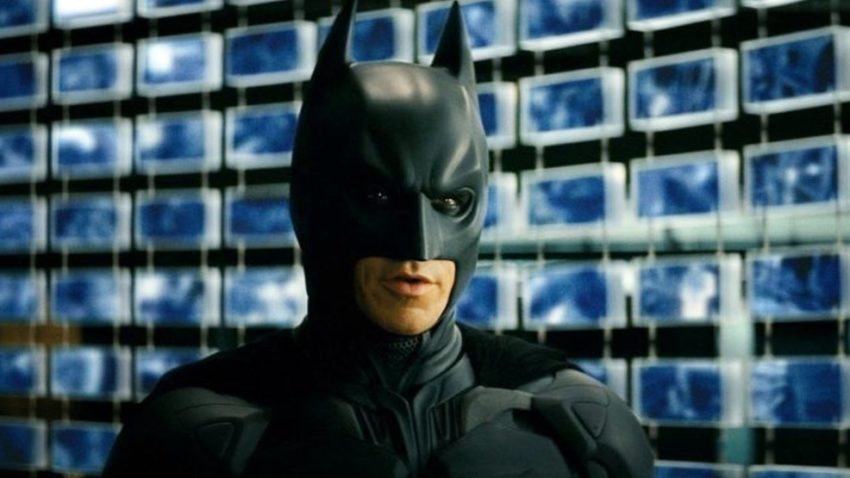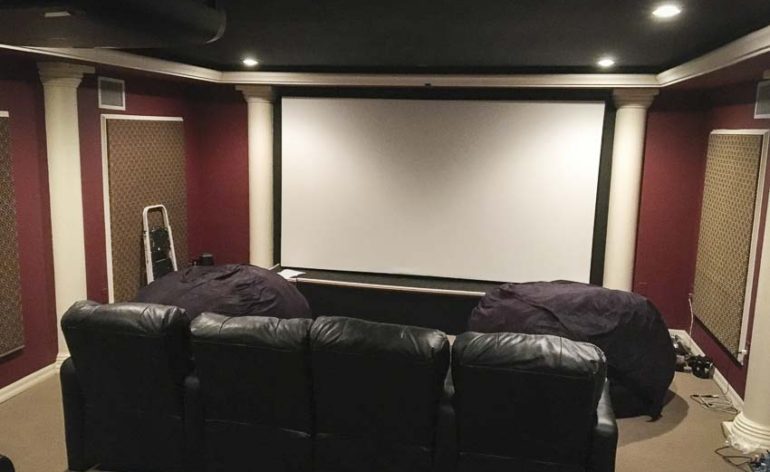Why 16:9 is the Best Projector Screen Aspect Ratio
We’ve seen it happen all too often. Someone goes online to look for suggestions for a new TV. Then they start reading about soundbars. Then they start exploring full surround sound…and down the rabbit hole they go. The next thing you know, they are trying to gut their basement and install a full home theater. It’s fine. We’ve all done it. But one question we get more often than we should is the question of the best projector screen aspect ratio. See, people have read that they should get a 2.35:1 screen with an anamorphic lens for the “true” cinematic experience. That just isn’t true. We say that 16:9 is the best projector screen aspect ratio.
What do the Numbers Mean Again?

The aspect ratio tells you the difference between the horizontal and vertical edges of the screen. This is different than the screen size you are used to seeing when you buy a display. The size (usually in inches) is the diagonal measurement. 16:9 (can also be expressed as 1.78:1 or referred to as IMAX) is the standard size for your HDTV. 2.35:1 is the wider format used in movies.
In the simplest terms, the numbers indicate how many units in the horizontal versus the vertical dimensions. We use inches but it could be anything. 16:9 means that for every 16 units horizontal, you must have 9 vertical (do the math and that equals 1.78 horizontal for each unit vertical). 2.35:1 is naturally a skinner (top to bottom) than the 16:9 options.
Why Does the Aspect Ratio Matter?
When you choose a screen aspect ratio, you are really choosing where you want your black bars. If you have a 16:9 screen, the black bars will appear on the top and bottom when viewing 2.35:1 content. This makes the image smaller than the 16:9 content. Vice versa, if you have a 2.35:1 screen, the 16:9 content will have black bars on the sides making the 16:9 content smaller. This leads us to one of the major reasons people advocate for the 2.35:1 screen over the 16:9 as the best projector screen aspect ratio.
Movies are Meant to be BIG!
Which should be the more cinematic experience? Watching reruns of The West Wing or the latest release from the studios? Which do you expect to have a bigger image? Tiger King or your favorite art-house horror movie? Obviously, the movie should be the largest and the most impressive experience. Right?
While we can understand the thought process, the reality is that the industry disagrees. Nearly every direct-view display on the market is 16:9. Nearly all content made for traditional TV stations and streaming services is shot in 16:9. So are you going to spend most of your time viewing a smaller portion of your screen just so you can have a cinematic experience with movies? Seems like a waste of screen size to us.
But I’m Going to be Mostly Watching Movies…
You yell at your computer screen as you read this. First of all…really? Do you think you’ll only power up the home theater for movies? You will rarely watch TV or stream? And no video games in the home theater, right? Because they are all 16:9 too. Heck, there are movies (The Dark Knight comes to mind) where the image switches from 2.35:1 to 16:9 during the movie! How are you going to deal with that? I’ll tell you how: The image will now be projected above and below the screen or will be smushed into the center with black bars on the side (making the 16:9 IMAX portion smaller, not the intent of the director).

When 2.35:1 movies are released for the home, they EXPECT there to be black bars on the bottom of the image for home releases. For that reason, they’ll put the subtitles inside those bars. We’ve even seen movies (the 2016 Ghostbusters comes to mind ) that have used those black bars in ways that were never in the original film.
Just SO Many Reasons 16:9 is the Best Projector Screen Ratio
Let’s be honest: People come up with a lot of reasons for opting for a 2.35:1 screen aspect ratio. But they are all just justifications. We’ve already addressed some reasons that 16:9 is the best projector screen aspect ratio. In addition, if you are looking for the most versatile, least expensive screen, 16:9 is the clear choice. For similar viewable real estate, the 16:9 screen will be less per square inch.
Cost
But that’s not all. To really do a 2.35:1 screen right, you’ll need to invest in a projector that can work with an anamorphic lens setup. The anamorphic lens isn’t exactly inexpensive (especially if you go for a motorized one) and it limits the projector options you have available. On a side note, when you watch The Dark Knight, have fun experiencing the IMAX portions squished and stretched into your 2.35:1 screen. Because that’s what’ll happen. Suddenly that extra-large, extra-impressive sweeping view Christopher Nolan was trying to show you is now short, fat, and confusing for all your viewers.
Your other option is to get a projector with lens memory. This allows you to zoom out for 2.35:1 (essentially projecting the black bars above and below the screen) and back in for 16:9. Again, this increases the price points of your projector options and limits the number you have to choose from. It also means that you have to worry about anything in the black bars (like subtitles or the few IMAX scenes) being projected on your wall. Be prepared to black out a larger area above and below your screen just in case. Another expense.
Back in Black
Really, the problem most people have with 2.35:1 content is that, historically, the black bars haven’t been all that black. Projectors and LCD TVs haven’t had the best black levels. The slightly glowing black bars some find as a distraction. We get that. But technology has improved. The higher-end JVC projectors have excellent black levels (no, they are not pure black, but they are very dark). OLED TVs black bars are truly black. Higher-end LCDs, with increasing numbers of local dimming zones are also doing much better. Yes, these types of displays cost more. But none of them cost so much more that you can find an anamorphic lens setup for less.
Too Cool for School

Lastly, let’s get to the REAL reason people want a 2.35:1 screen and anamorphic lens setup: It’s cool. None of their friends have them. It gives them bragging rights. But the dirty secret of the motorized anamorphic lens is that it all happens behind you. You’ll hear the lens slide into place. You might even catch a bit of it on the screen as the projector warms up. But no one other than you will really know what is going on. So be prepared to explain how cool your setup is if you want your friends to know what is happening. If you REALLY want to impress your friends, look at a motorized masking system for your 16:9 screen (like this one from Seymour AV). With this system, you can have your screen automatically adjust to the image size in front of your friends. You won’t have to explain what is going on because they can SEE it. And doesn’t that have way more ‘cool’ factor?
Admit it: 16:9 IS the Best Projector Screen Aspect Ratio
16:9 is the most versatile and least expensive aspect ratio for your projector screen. That should be reason enough to admit that 16:9 is the best projector screen aspect ratio. When you consider the benefits of having the screen size that works with most of the content (including games) and the fact that you can add a motorized masking screen to give your theater that ‘wow’ factor you are looking for, 16:9 is the hands-down winner.



You must work at best buy. Btw, that’s not a compliment.
Shabby article that misses the point entirely.
This sounds like it was written by someone that just wanted to yell their opinion more than give helpful information.
What a completely clueless “article”
Take it down so you dont hurt your reputation even more